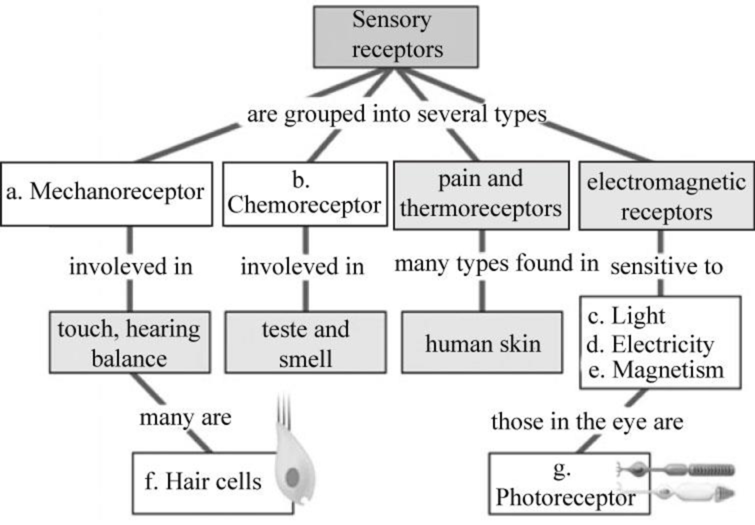
Concept explainers
To label: The sensory receptor that receives stimuli from the environment and also list the responses they show in respect to stimuli.
Concept introduction:
Sensory receptors are the structures that send stimuli to brain after receiving it in response to changes in the environment. They convey the signal to neurons from the external or internal body. Sensory receptors are present on sensory organs, namely, eyes, skin, and ear.
Explanation of Solution
Pictorial representation:
Fig.1 shows the types of sensory receptors present in humans and responses they generate.

Fig.1: Shows the type of sensory receptors and their responses.
(a)
Correct answer: Mechanoreceptor.
Plasma membrane contains a mechanogated ion channel that opens or closes in response to the stimuli. When there is a pressure applied on the membrane by stretching or twisting, the channels get activated. For example, the tympanic wall present in the ear has a mechanogated ion channel, and it helps in hearing by transmission of sound vibration. Hence, the correct answer is mechanoreceptors.
(b)
Correct answer: Chemoreceptor.
Chemoreceptors have an autonomic control, and they get stimulated by the change in the chemical concentration in the environment. Generally, they are found in the nose and mouth. Hence, the correct answer is chemoreceptors.
(c)
Correct answer: Light.
(d)
Correct answer: Electricity.
Some organisms have the ability to detect electrical energy; their electroreceptors receive the stimulus and send it to the brain for detection. For example, sharks can detect electricity that is generated by any muscular activity. Hence, the correct answer is electricity.
(e)
Correct answer: Magnetism.
Electromagnetic receptors sense the magnetic field in the environment. Birds use the magnetic field of the Earth in navigation when they migrate. Hence, the correct answer is magnetism.
(f)
Correct answer: Hair cells.
Hair cells have mechanoreceptors that generate an electrical stimulus upon stretching or when the cell feels any pressure; for example, hair cells present in the ear have receptors that detect head movement and sound. Hence, the correct answer is hair cells.
(g)
Correct answer: Photoreceptor.
Photoreceptors are present in the retina of the eye and receive the stimulus from light. Photoreceptors convert light into electric signal and send it to the brain for visual transduction. Hence, the correct answer is photoreceptor.
Want to see more full solutions like this?
Chapter 29 Solutions
CAMPBELL BIOLOGY:CONCEPTS+CONNECTIONS
- students in a science class investiged the conditions under which corn seeds would germinate most successfully. BAsed on the results which of these factors appears most important for successful corn seed germination.arrow_forwardI want to write the given physician orders in the kardex formarrow_forwardAmino Acid Coclow TABle 3' Gly Phe Leu (G) (F) (L) 3- Val (V) Arg (R) Ser (S) Ala (A) Lys (K) CAG G Glu Asp (E) (D) Ser (S) CCCAGUCAGUCAGUCAG 0204 C U A G C Asn (N) G 4 A AGU C GU (5) AC C UGA A G5 C CUGACUGACUGACUGAC Thr (T) Met (M) lle £€ (1) U 4 G Tyr Σε (Y) U Cys (C) C A G Trp (W) 3' U C A Leu בוט His Pro (P) ££ (H) Gin (Q) Arg 흐름 (R) (L) Start Stop 8. Transcription and Translation Practice: (Video 10-1 and 10-2) A. Below is the sense strand of a DNA gene. Using the sense strand, create the antisense DNA strand and label the 5' and 3' ends. B. Use the antisense strand that you create in part A as a template to create the mRNA transcript of the gene and label the 5' and 3' ends. C. Translate the mRNA you produced in part B into the polypeptide sequence making sure to follow all the rules of translation. 5'-AGCATGACTAATAGTTGTTGAGCTGTC-3' (sense strand) 4arrow_forward
- What is the structure and function of Eukaryotic cells, including their organelles? How are Eukaryotic cells different than Prokaryotic cells, in terms of evolution which form of the cell might have came first? How do Eukaryotic cells become malignant (cancerous)?arrow_forwardWhat are the roles of DNA and proteins inside of the cell? What are the building blocks or molecular components of the DNA and proteins? How are proteins produced within the cell? What connection is there between DNA, proteins, and the cell cycle? What is the relationship between DNA, proteins, and Cancer?arrow_forwardWhy cells go through various types of cell division and how eukaryotic cells control cell growth through the cell cycle control system?arrow_forward
 Human Anatomy & Physiology (11th Edition)BiologyISBN:9780134580999Author:Elaine N. Marieb, Katja N. HoehnPublisher:PEARSON
Human Anatomy & Physiology (11th Edition)BiologyISBN:9780134580999Author:Elaine N. Marieb, Katja N. HoehnPublisher:PEARSON Biology 2eBiologyISBN:9781947172517Author:Matthew Douglas, Jung Choi, Mary Ann ClarkPublisher:OpenStax
Biology 2eBiologyISBN:9781947172517Author:Matthew Douglas, Jung Choi, Mary Ann ClarkPublisher:OpenStax Anatomy & PhysiologyBiologyISBN:9781259398629Author:McKinley, Michael P., O'loughlin, Valerie Dean, Bidle, Theresa StouterPublisher:Mcgraw Hill Education,
Anatomy & PhysiologyBiologyISBN:9781259398629Author:McKinley, Michael P., O'loughlin, Valerie Dean, Bidle, Theresa StouterPublisher:Mcgraw Hill Education, Molecular Biology of the Cell (Sixth Edition)BiologyISBN:9780815344322Author:Bruce Alberts, Alexander D. Johnson, Julian Lewis, David Morgan, Martin Raff, Keith Roberts, Peter WalterPublisher:W. W. Norton & Company
Molecular Biology of the Cell (Sixth Edition)BiologyISBN:9780815344322Author:Bruce Alberts, Alexander D. Johnson, Julian Lewis, David Morgan, Martin Raff, Keith Roberts, Peter WalterPublisher:W. W. Norton & Company Laboratory Manual For Human Anatomy & PhysiologyBiologyISBN:9781260159363Author:Martin, Terry R., Prentice-craver, CynthiaPublisher:McGraw-Hill Publishing Co.
Laboratory Manual For Human Anatomy & PhysiologyBiologyISBN:9781260159363Author:Martin, Terry R., Prentice-craver, CynthiaPublisher:McGraw-Hill Publishing Co. Inquiry Into Life (16th Edition)BiologyISBN:9781260231700Author:Sylvia S. Mader, Michael WindelspechtPublisher:McGraw Hill Education
Inquiry Into Life (16th Edition)BiologyISBN:9781260231700Author:Sylvia S. Mader, Michael WindelspechtPublisher:McGraw Hill Education





